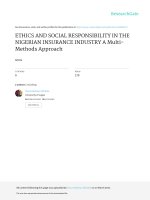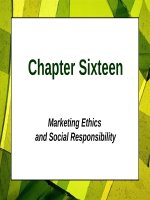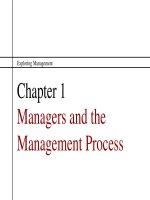Lecture Exploring management - Chap 3: Ethics and social responsibility
Bạn đang xem bản rút gọn của tài liệu. Xem và tải ngay bản đầy đủ của tài liệu tại đây (1.29 MB, 36 trang )
Exploring Management
Chapter 3
Ethics and
Social Responsibility
Chapter 3
•
•
•
How do ethics and ethical behavior play
out in the workplace?
How can we maintain high standards of
ethical conduct?
What should we know about the social
responsibilities of organizations?
3.1
Ethics in the workplace
•
•
•
•
•
Ethical behavior is values driven.
What is considered ethical varies among
moral reasoning approaches.
What is considered ethical can vary
across cultures.
Ethical dilemmas arise as tests of
personal ethics and values.
People have tendencies to rationalize
unethical behaviors.
ethics in the workplace
Ethical Behavior
•
Ethics
–
•
A code of moral principles that sets standards
of good or bad, or right or wrong, in our
conduct.
Ethical Behavior
–
That which is “right” or “good” in the context of
governing moral code.
–
Ethical behavior is value driven
ethics in the workplace
Values
•
Values
–
•
Terminal Values
–
•
Broad beliefs about what is appropriate
behavior
Preferences about desired end states
Instrumental Values
–
Preferences regarding the means to desired
ends
ethics in the workplace
Moral Reasoning
•
Moral Reasoning
–
Reasons for various ethical practices
ethics in the workplace
Moral Reasoning
•
Utilitarian View
–
Which action delivers the most good to the
largest amount of people?
ethics in the workplace
Moral Reasoning
•
Individualism View
–
Which action is in our best interest in the longterm?
–
Can be quite different from the best choice for
the short term
ethics in the workplace
Moral Reasoning
•
Justice View
ethics in the workplace
Moral Reasoning
•
Moral Rights View
–
Fundamental rights of all people are
respected
ethics in the workplace
Moral Reasoning
Excerpt From Universal Declaration of Human Rights
United Nations
•
•
•
•
•
Article 1—All human beings are born free and equal in
dignity and right
Article 18—Everyone has the right to freedom of thought,
conscience, and religion
Article 19—Everyone has the right to freedom of opinion
and expression
Article 23—Everyone has the right to work, to free choice
of employment, to just and favorable conditions of work
Article 26—Everyone has the right to education
ethics in the workplace
Ethics and Culture
•
Cultural Relativism
–
Suggest that there is no one right way to
behave; cultural context determines ethical
behavior
ethics in the workplace
Ethical Dilemma
•
Ethical Dilemma
–
A situation that, although offering potential
benefits, is unethical.
–
One of the most common ethical dilemmas
occurs when a company’s culture conflicts
with an employee’s
personal ethics.
ethics in the workplace
Ethics and Work
The Wall Street Journal reports:
• 36% of workers calling in sick are lying.
• 35% keep quiet about co-worker misconduct.
• 12% of job resumes contain falsehoods.
• Managers are more likely than other workers to
report wrongdoing.
• Managers with 0–3 years experience feel most
pressure to violate personal ethics.
ethics in the workplace
Rationalizing Unethical Behavior
Four reasons:
3.2
Maintaining high standards
•
•
•
•
•
Personal factors moral development
influence ethical conduct.
Training in ethical decision making may
improve ethical conduct.
Protection of whistleblowers may
encourage ethical conduct.
Managers acting as positive role models
can inspire ethical conduct.
Formal codes of ethics set standards for
ethical conduct
maintaining high standards
Influence on Moral Development
•
Ethical Frameworks
–
•
Personal rules and strategies for making
ethical decisions
Lawrence Kohlberg
–
Three levels of moral development
maintaining high standards
Ethics Training
•
Ethics Training
–
Seeks to help people understand the ethical
aspects of decision making and to incorporate
high ethical standards into their daily
behavior.
ethics in the workplace
Ethical Dilemma
•
Checklist for dealing with ethical dilemmas
Step 1
Recognize the ethical dilemma.
Step 2
Get the facts.
Step 3
Identify your options.
Step 4
Test each option: Is it legal? Is it right? Is it beneficial?
Step 5
Decide which option to follow.
Step 6
Ask the “Spotlight Questions”: To double check your
decision.
“How would I feel if my family found out about my
decision?”
“How would I feel if the local newspaper printed my
decision?”
Step 7
Take action
maintaining high standards
Ethics Training
Spotlight questions highlight the
risk of public exposure of one’s
actions:
•
•
•
How would I feel if my family found out
about my decision?
How would I feel if my decision was in
the local newspaper or posted on the
internet?
What would the person I know who
has the strongest character and best
maintaining high standards
Whistleblowing
•
Whistleblowers
–
Persons who expose organizational misdeeds
in order to preserve ethical standards and
protect against wasteful, harmful, or illegal
acts.
–
Many whistleblowers were / are fired for their
actions.
–
State and federal laws now offer some
protection.
maintaining high standards
Whistleblowing
•
Organizational barriers to whistleblowing
–
Strict chain of command
–
Strong work group identities
–
Ambiguous priorities
maintaining high standards
Management Influence
•
Management Behavior
–
In order to have a positive impact on ethical
conduct throughout an organization, those at
the top must walk the talk.
Maintaining high standards
Codes of Ethics
•
Formal codes of ethics set standards for
ethical conduct.
–
Explain ethical principles
–
Describe expected behavior
3.3
Social Responsibility
•
•
•
•
•
Social responsibility is an organization’s
obligation to best serve society
Scholars argue cases for and against
corporate social responsibility
Social responsibility audits measure the
social performance of organizations
Sustainability is an important social
responsibility goal
Social business and social entrepreneurs
point the way in social responsibility









